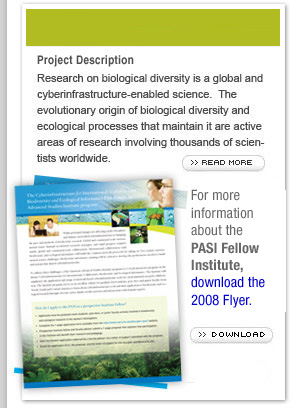C1. Research on Biological Diversity
Biological diversity, or simply biodiversity, is
the sum of life on Earth – plants, animals
and microbes – encompassing all levels of biological
organization from genomes to species to ecosystems.
Approximately 1.8 million species are known as a
result of 300 years of the biological exploration
of the planet. Astonishingly, an estimated 15-50
million species await discovery and basic description. A
grand challenge for the 21st century science is to
expand and harness knowledge of Earth's biological
diversity and to understand how it shapes the global
environmental systems on which all of life depends.
This knowledge is critical to science and society
for rational policy for managing natural systems,
sustaining human health, maintaining economic stability,
and improving the quality of human life. The urgency
for this knowledge increases daily as the conversion
of natural systems to human-managed systems accelerates
the decline of biological diversity at all levels
of organization.
The importance of biodiversity research
and education has been established by a series of
landmark reports: U.S. NSF’s Task Force
on Global Biodiversity (Black et al., 1989),
the systematics and biological collections community’s Systematics
Agenda 2000 (1994), the Australian government’s The
Darwin Declaration (Environment Australia, 1998),
Biodiversity II: Understanding and Protecting Our
Biological Resources (Reaka-Kudla et al., 1997),
and the U. S. President’s Committee on Science
and Technology’s Teaming with Life (Lane,
1998).
Ecological and systematics research,
which is aimed at elucidating the evolutionary history,
geospatial pattern, community structure and ecosystem
processes involved in the creation and maintenance
of biological diversity, is becoming increasingly
data-driven (Bisby, 2000; Bisby et al. 2002; Causey
et al. 2004). Cyberinfrastructure is enabling
this transformation, and as more primary sources
of historic and real-time environmental data streams
come on-line, the role of networked information services
and collaboration technologies will continue to expand
(Edwards, et al. 2000; Withey, et al. 2002). Biodiversity
data is increasing at the rate 107 new records per
year. Libraries, museums and research centers are
grappling with the issues of dealing with the deluge
of data in a stable, online and integrative way (Berman
and Brady, 2005).
Read Entire Project Description,
download here in
PDF format
|




